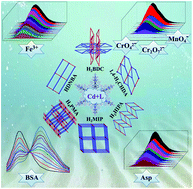Various Cd(ii) coordination polymers induced by carboxylates: multi-functional detection of Fe3+, anions, aspartic acids and bovine serum albumin†
Abstract
By adjusting carboxylates, six Cd(II) coordination polymers based on a naphthalene–methylene mixed-bridged-amide ligand, [Cd(L)(DNBA)2] (1), [Cd2(L)2(BDC)2(H2O)2]·2H2O (2), [Cd(L)(1,4-CHDA)] (3), [Cd(L)(HIPA)(H2O)]·H2O (4), [Cd(L)(MIP)]·H2O (5), and [Cd(L)(PMA)0.5(H2O)]·H2O (6) [L = N,N′-bis(4-methylenepyridin-4-yl)-1,4-naphthalene dicarboxamide, HDNBA = 3,5-dinitrobenzoic acid, H2BDC = 1,4-benzenedicarboxylic acid, 1,4-H2CHDA = 1,4-cyclohexanedicarboxylic acid, H2HIPA = 5-hydroxyisophthalic acid, H2MIP = 5-methylisophthalic acid and H4PMA = pyromellitic acid] have been synthesized under hydrothermal conditions. 1 shows a 4-c sql coplanar structure. 2 exhibits a 2-fold vertical interpenetrating structure based on wave-like 4-c sql layers. 3 shows a (3,5)-c pnh network containing a unique μ3-L. 4 features a 4-c sql wave-like network. 5 and 6 exhibit 3D structures with 6-c pcu and 4-c mog topologies. The number of carboxyl groups and functional group positions of the carboxylates have an important influence on the structures of the title complexes. The fluorescent responses of 1–6 towards Fe3+, anions, aspartic acid and bovine serum albumin were investigated. Among them, 4 shows sensitivity and selectivity (KSV = 1.16 × 104 L mol−1 for Fe3+, 1.03 × 104 L mol−1 for CrO42−, 1.08 × 104 L mol−1 for Cr2O72−, 1.17 × 104 L mol−1 for MnO4− and 1.05 × 104 L mol−1 for aspartic acid).



 Please wait while we load your content...
Please wait while we load your content...